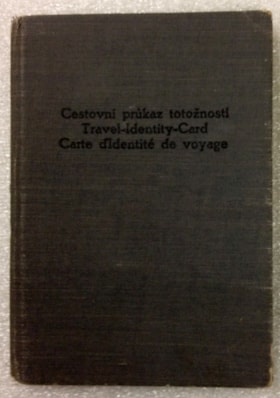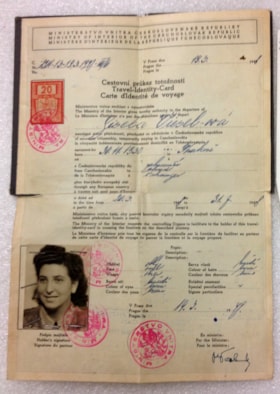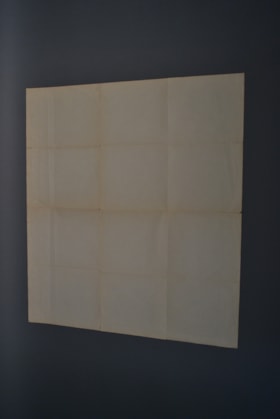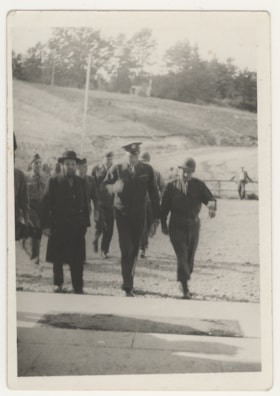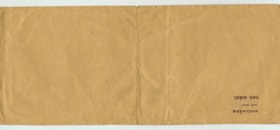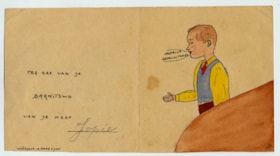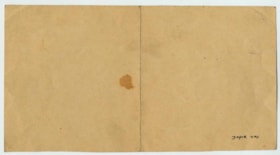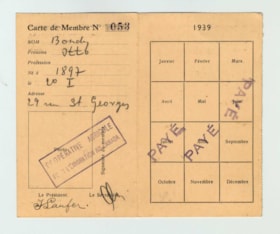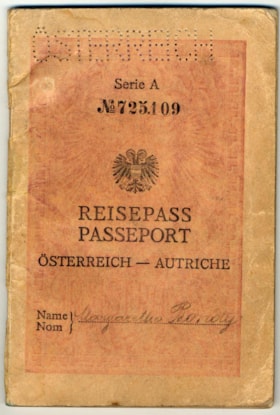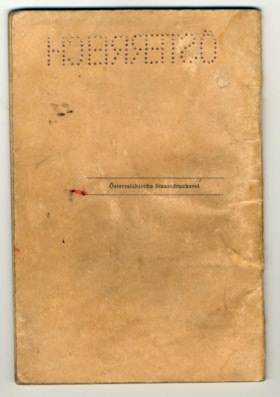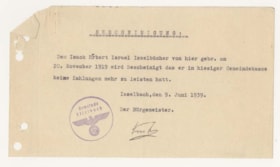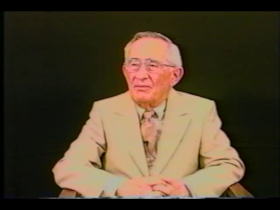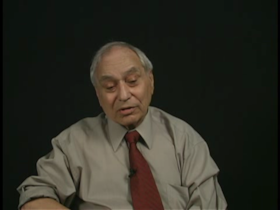Narrow Results By
Collection
- Abe Carlofsky fonds 1
- Album of Jewish Legion Collection 1
- Alex Betcherman fonds 1
- Allan Raymond Collection 3
- Archibald and Lillian Freiman family fonds 1
- B'nai B'rith Ottawa Lodges Fonds 2
- BAILLEHACHE, Soeur Marie-Noelle de. 1
- BATSHAW, Justice Harry 1
- BECKER, Lavy M. 1
- BELLER, Jacob. 1
- BENSIMON, Jacques = '20 ans apres' - film out-takes fonds 1
- Benditsky Family Fonds 1
Name
- - 2
- 1 brother, 2 sisters 1
- 1 brother - Herman F., 5 sisters - Doris, Mrs. Minnie Feldman, Mrs. Jack Zuckerman 1
- 1 brother - Hyman Jacobson, 1 sister - Mrs. H. Selick 1
- 1 brother - Jack, 1 sister - Celia 1
- 1 daughter - Edith Jacobson 1
- 1 daughter - Gloria Pink 1
- 1 half brother - Louis Bloom, 2 sisters - Teresa Jacobson, Mrs. J. Jaffe 1
- 1 sister 1
- 1 son - Joseph, 2 daughters - Doris (Mrs. B.) Jacobson, Frances 1
- 1 step-son - Dr. Melvin Freedman, 1 step-daughter - Ellen Hochberger 1
- 2 brothers, 2 sisters 1
Place
- Alamein Memorial 1
- Amsterdam, Netherlands, Europe 1
- Bad Wurzach, Germany, Europe 5
- Beny-sur-Mer Canadian War Cemetery, Reviers 1
- Bergen-Belsen, Germany, Europe 1
- Berlin, Germany, Europe 1
- Bretteville-sur-Laize Canadian War Cemetery 1
- Brussels, Belgium, Europe 2
- Calvados, France 2
- Czech Republic (Protectorate of Bohemia and Moravia), Europe 2
- Drancy, France, Europe 1
- Egypt 1
Subject
- 75% of all children in Eastern Europe, 50% in Western Europe and 100% in DP countries depending on relief - JDC reports 1
- Abbey, Stanley 3
- Administrative information 1
- A. I. SILVER 1
- AJDC - Country Director's Conference 1
- American Jewish Joint Distribution Committee (JDC) - Country Directors Conference, Paris 1
- Amphitheatres. 10
- Appearance of artists who were in enemy countries - with Nazi Record, stand by Congress 1
- Archery. 1
- Art gallery 1
- Awards 2
- Baseball. 1
Joel Zolna, his brother-in-law and a friend
https://www.cjhn.ca/link/cjhn45873
- Collection
- Montreal Holocaust Museum
- Description Level
- Item
- Material Type
- graphic material
- Physical Description
- Photograph : Paper ; Ht: 2 1/2 in. x W: 3 1/4 in.
- Date
- August 4, 1934
- Collection
- Montreal Holocaust Museum
- Description Level
- Item
- Material Type
- graphic material
- Physical Description
- Photograph : Paper ; Ht: 2 1/2 in. x W: 3 1/4 in.
- Other Title Information
- Documentary Artifact
- Date
- August 4, 1934
- Physical Condition
- Good
- Notes
- b&w with white border, outdoor scene. Joel Zolna, his future brother-in-law and one friend on bicycles with arms around each other, on a country road.
- Accession No.
- 2011X.369.05
- Name Access
- Zolna, Joel
- Places
- Lodz, Poland, Europe
- Archival / Genealogical
- Archival Descriptions
- Repository
- Montreal Holocaust Museum
Images
Identification card
https://www.cjhn.ca/link/cjhn47888
- Collection
- Montreal Holocaust Museum
- Description Level
- Item
- Material Type
- textual record
- Physical Description
- Identification card : printed, bound, photography : grey, black beige, blue, red, pink ; Ht: 14,7 cm x W: 10,4 cm
- Date
- March 19, 1948
- Collection
- Montreal Holocaust Museum
- Description Level
- Item
- Material Type
- textual record
- Physical Description
- Identification card : printed, bound, photography : grey, black beige, blue, red, pink ; Ht: 14,7 cm x W: 10,4 cm
- Other Title Information
- Documentary Artifact
- Date
- March 19, 1948
- Physical Condition
- Good
- Language
- English
- French
- Czech
- Notes
- Hardcover, cardboard bound with string and glue. Cover is grey woven fabric with the title printed in black in the centre; the back cover is blank. Interior is beige; the pages are made from 1 large piece of paper, folded 8 times. The page unfolds vertically, revealing the identity card of the passport holder: black typewritten text with handwriting in blue ink filling in the blank fields; there is a red stamp at the top left corner, overlaid with a pink ink stamp (see inscriptions) and a b&w photograph of a woman from the shoulders up on the bottom left corner; 2 pink ink stamps are found overlapping on the photo (see inscriptions), and 1 is stamped at the bottom centre. After the unfolding the page initially, it then unfolds horizontally to show several travel stamps and visas for Prague, France, the US Zone in Germany and Canada. Narrative: This is a Travel Identity Card of Gisela Viesel-ova . This kind of certificate was published after the second world war by the Ministry of interior of the Czechoslovak Republic. The owner of this ID-card is allowed to move from Czechoslovakia to another European country.
- Accession No.
- 2000.31.03
- Name Access
- Luger, Solomon
- Archival / Genealogical
- Archival Descriptions
- Repository
- Montreal Holocaust Museum
Images
German-Russian Front
https://www.cjhn.ca/link/cjhn48182
- Collection
- Montreal Holocaust Museum
- Description Level
- Item
- Material Type
- cartographic material
- Physical Description
- Map : printed : black, beige, yellow, green
- Date
- 1939-1945
- Collection
- Montreal Holocaust Museum
- Description Level
- Item
- Material Type
- cartographic material
- Physical Description
- Map : printed : black, beige, yellow, green
- Other Title Information
- Documentary Artifact
- Date
- 1939-1945
- Physical Condition
- Good
- Language
- English
- Notes
- Map, printed on newsprint; colour coordinated to correspond with the legend printed at the top right corner. Shows Russia (USSR), land occupied by Russia, Germany, countries occupied by Germany and Italy, as well as neutral countries.
- Accession No.
- 2012X.65.01
- Name Access
- MHMC
- Places
- Germany, Europe
- Archival / Genealogical
- Archival Descriptions
- Repository
- Montreal Holocaust Museum
Images
Location of Camps in Germany and Occupied Countries
https://www.cjhn.ca/link/cjhn48183
- Collection
- Montreal Holocaust Museum
- Description Level
- Item
- Material Type
- cartographic material
- Physical Description
- Map : Printed : Beige, black
- Collection
- Montreal Holocaust Museum
- Description Level
- Item
- Material Type
- cartographic material
- Physical Description
- Map : Printed : Beige, black
- Other Title Information
- Documentary Artifact
- Physical Condition
- Poor
- Language
- English
- German
- Polish
- Notes
- Map, printed on newsprint; b&w. Shows the location of the different camps in Germany and the occupied countries; a legend is printed at the bottom right corner.
- Accession No.
- 2012X.66.01
- Name Access
- MHMC
- Places
- Europe
- Archival / Genealogical
- Archival Descriptions
- Repository
- Montreal Holocaust Museum
Images
Philips’ War Map of the World
https://www.cjhn.ca/link/cjhn48184
- Collection
- Montreal Holocaust Museum
- Description Level
- Item
- Material Type
- cartographic material
- Physical Description
- Map : printed : beige, green, black, white, brown, blue, red, purple, yellow, orange, pink
- Date
- 1941
- Collection
- Montreal Holocaust Museum
- Description Level
- Item
- Material Type
- cartographic material
- Physical Description
- Map : printed : beige, green, black, white, brown, blue, red, purple, yellow, orange, pink
- Other Title Information
- Documentary Artifact
- Date
- 1941
- Physical Condition
- Poor
- Language
- English
- Notes
- Map of the world, folded like a booklet with the title and publishing information printed on the front panel. Each country is colour coordinated, depending on their role in the war; many curved lines connect different countries/cities/continents; a legend is printed at the bottom left corner, explaining the colours and lines found on the map.
- Accession No.
- 2012X.67.01
- Name Access
- MHMC
- Archival / Genealogical
- Archival Descriptions
- Repository
- Montreal Holocaust Museum
Images
Group of men 1945
https://www.cjhn.ca/link/cjhn49991
- Collection
- Montreal Holocaust Museum
- Description Level
- Item
- Material Type
- graphic material
- Physical Description
- Photograph : paper : b&w ; Ht: 10,6 cm x W: 7,4 cm
- Collection
- Montreal Holocaust Museum
- Description Level
- Item
- Material Type
- graphic material
- Physical Description
- Photograph : paper : b&w ; Ht: 10,6 cm x W: 7,4 cm
- Other Title Information
- Documentary Artifact
- Physical Condition
- Good
- Notes
- White border. Outdoor scene. Group of men, mostly soldiers, walking towards pavement. Behind them is a a fence, a country road, a hill and some trees.
- Accession No.
- 2012.31.01
- Name Access
- Monheit, Robert
- Places
- France, Europe
- Archival / Genealogical
- Archival Descriptions
- Repository
- Montreal Holocaust Museum
Images
Card
https://www.cjhn.ca/link/cjhn50311
- Collection
- Montreal Holocaust Museum
- Description Level
- Item
- Material Type
- textual record
- Physical Description
- Card : Paper : Ink : Black, Yellow, Beige ; Ht: 4 in. x W: 9,3 in.
- Date
- February 24, 1945
- Collection
- Montreal Holocaust Museum
- Description Level
- Item
- Material Type
- textual record
- Physical Description
- Card : Paper : Ink : Black, Yellow, Beige ; Ht: 4 in. x W: 9,3 in.
- Other Title Information
- Documentary Artifact
- Date
- February 24, 1945
- Physical Condition
- Excellent
- Language
- Dutch
- Hebrew
- Notes
- 1 page. The right hand side shows the tablets of the law written in Hebrew with the Star of David on top. Left hand side is a message of congratulations. Narrative: Donor's grandfather was born in Britain in 1895. He moved to Holland when he was six years old . The family therefore qualified for British citizenship. Donor's father applied for British identification papers. Donor Nettie and her brother Joseph went briefly into hiding but their mother wanted the family together so they returned to Amsterdam. The family was rounded up on March 17th 1943, and taken to the Stadsschouwburg (a big cinema with seats removed) in Amsterdam where they stayed for about a week. From there they were sent to the camp of Westerbork, where they stayed for a couple of months. In the summer time they were sent to another camp in Amersfoort for about 4-6 weeks. They were afterwards sent back to Westerbork and at the beginning of 1944, the entire family was sent to Bergen-Belsen concentration camp in Germany. In Bergen-Belsen, the men and women were separated; the children from the age of 14 were sent to work. Nettie was considered small in stature, she lied about her age so she didn’t have to go to work. Her sister was three years older and was sent to work in the kitchen. Their father worked in a shoe factory and their mother worked in the kitchen peeling potatoes. Joseph (Nettie's younger brother) stayed in the camp with her. The family stayed in Bergen-Belsen until the end of 1944 (circa October or December) when they were sent to Wurzach with about. While on the train to Wurzach, the family had a separate carriage and they were told to take off the yellow stars because they were now considered internees. Additional research shows that in the winter 1944/1945 the castle of Bad Wurzach (160 km south of Stuttgart) served as a stopover for 72 Jewish prisoners from the concentration camp Bergen-Belsen. They were Jews from Holland, who were foreign nationals, meaning they had either the British or U.S. citizenship or at least papers from South and Central American countries, and were regarded as "exchangeable" over German nationals in Allied custody. They had been sent in two shipments in the fall and winter from concentration camps in Germany, in order to be exchanged in Switzerland against German citizens held by the Allies. They were sent to different internment camps of Württemberg: Liebenau, Biberach and Wurzach. According to internees from Jersey already living in Bad Wurzach, the so-called "exchange Jews" were in a terrible state when they arrived; they were starved and scared. Through improved nutrition and the additional Red Cross parcels, they recovered relatively quickly. Only one of them perished in Wurzach . While in Wurzach, Joseph celebrated his bar mitzvah on February 24th, 1945; many internees including non-Jewish internees were present. Coffee and cakes were served; thanks to a monthly parcel from POWs (milk, sugar, cocoa) which had been saved to be used for the occasion. Joseph received bar mitzvah cards made by attendees. The family stayed in Wurzach until the end of April when the camp was liberated.
- Accession No.
- 1990.13.03
- Name Access
- Herscher, Nettie
- Places
- Bad Wurzach, Germany, Europe
- Archival / Genealogical
- Archival Descriptions
- Repository
- Montreal Holocaust Museum
Images
Card
https://www.cjhn.ca/link/cjhn50312
- Collection
- Montreal Holocaust Museum
- Description Level
- Item
- Material Type
- textual record
- Physical Description
- Card : Paper : Ink; Pencil : Blue, Red, Black, Beige ; Ht: 5 in. x W: 12 in.
- Date
- February 24, 1945
- Collection
- Montreal Holocaust Museum
- Description Level
- Item
- Material Type
- textual record
- Physical Description
- Card : Paper : Ink; Pencil : Blue, Red, Black, Beige ; Ht: 5 in. x W: 12 in.
- Other Title Information
- Documentary Artifact
- Date
- February 24, 1945
- Physical Condition
- Excellent
- Language
- Dutch
- Notes
- 1 page. On the right hand side there is the Star of David above a Torah scroll with a pointer and a prayer book.Left side contains message of congratulations. Narrative: Donor's grandfather was born in Britain in 1895. He moved to Holland when he was six years old . The family therefore qualified for British citizenship. Donor's father applied for British identification papers. Donor Nettie and her brother Joseph went briefly into hiding but their mother wanted the family together so they returned to Amsterdam. The family was rounded up on March 17th 1943, and taken to the Stadsschouwburg (a big cinema with seats removed) in Amsterdam where they stayed for about a week. From there they were sent to the camp of Westerbork, where they stayed for a couple of months. In the summer time they were sent to another camp in Amersfoort for about 4-6 weeks. They were afterwards sent back to Westerbork and at the beginning of 1944, the entire family was sent to Bergen-Belsen concentration camp in Germany. In Bergen-Belsen, the men and women were separated; the children from the age of 14 were sent to work. Nettie was considered small in stature, she lied about her age so she didn’t have to go to work. Her sister was three years older and was sent to work in the kitchen. Their father worked in a shoe factory and their mother worked in the kitchen peeling potatoes. Joseph (Nettie's younger brother) stayed in the camp with her. The family stayed in Bergen-Belsen until the end of 1944 (circa October or December) when they were sent to Wurzach with about. While on the train to Wurzach, the family had a separate carriage and they were told to take off the yellow stars because they were now considered internees. Additional research shows that in the winter 1944/1945 the castle of Bad Wurzach (160 km south of Stuttgart) served as a stopover for 72 Jewish prisoners from the concentration camp Bergen-Belsen. They were Jews from Holland, who were foreign nationals, meaning they had either the British or U.S. citizenship or at least papers from South and Central American countries, and were regarded as "exchangeable" over German nationals in Allied custody. They had been sent in two shipments in the fall and winter from concentration camps in Germany, in order to be exchanged in Switzerland against German citizens held by the Allies. They were sent to different internment camps of Württemberg: Liebenau, Biberach and Wurzach. According to internees from Jersey already living in Bad Wurzach, the so-called "exchange Jews" were in a terrible state when they arrived; they were starved and scared. Through improved nutrition and the additional Red Cross parcels, they recovered relatively quickly. Only one of them perished in Wurzach . While in Wurzach, Joseph celebrated his bar mitzvah on February 24th, 1945; many internees including non-Jewish internees were present. Coffee and cakes were served; thanks to a monthly parcel from POWs (milk, sugar, cocoa) which had been saved to be used for the occasion. Joseph received bar mitzvah cards made by attendees. The family stayed in Wurzach until the end of April when the camp was liberated.
- Accession No.
- 1990.13.08
- Name Access
- Herscher, Nettie
- Places
- Bad Wurzach, Germany, Europe
- Archival / Genealogical
- Archival Descriptions
- Repository
- Montreal Holocaust Museum
Images
Card
https://www.cjhn.ca/link/cjhn50313
- Collection
- Montreal Holocaust Museum
- Description Level
- Item
- Material Type
- textual record
- Physical Description
- Card : Paper : Pencil; Ink : Yellow, Black, Blue, Red, White ; Ht: 4 in. x W: 7,5 in.
- Date
- February 24, 1945
- Collection
- Montreal Holocaust Museum
- Description Level
- Item
- Material Type
- textual record
- Physical Description
- Card : Paper : Pencil; Ink : Yellow, Black, Blue, Red, White ; Ht: 4 in. x W: 7,5 in.
- Other Title Information
- Documentary Artifact
- Date
- February 24, 1945
- Physical Condition
- Excellent
- Language
- Dutch
- Notes
- 1 page. Right hand side shows a drawing of young boy wearing shirt, sweater and tie with his hand extended and a text bubble coming from his mouth reading "congratulations" Narrative: Donor's grandfather was born in Britain in 1895. He moved to Holland when he was six years old . The family therefore qualified for British citizenship. Donor's father applied for British identification papers. Donor Nettie and her brother Joseph went briefly into hiding but their mother wanted the family together so they returned to Amsterdam. The family was rounded up on March 17th 1943, and taken to the Stadsschouwburg (a big cinema with seats removed) in Amsterdam where they stayed for about a week. From there they were sent to the camp of Westerbork, where they stayed for a couple of months. In the summer time they were sent to another camp in Amersfoort for about 4-6 weeks. They were afterwards sent back to Westerbork and at the beginning of 1944, the entire family was sent to Bergen-Belsen concentration camp in Germany. In Bergen-Belsen, the men and women were separated; the children from the age of 14 were sent to work. Nettie was considered small in stature, she lied about her age so she didn’t have to go to work. Her sister was three years older and was sent to work in the kitchen. Their father worked in a shoe factory and their mother worked in the kitchen peeling potatoes. Joseph (Nettie's younger brother) stayed in the camp with her. The family stayed in Bergen-Belsen until the end of 1944 (circa October or December) when they were sent to Wurzach with about. While on the train to Wurzach, the family had a separate carriage and they were told to take off the yellow stars because they were now considered internees. Additional research shows that in the winter 1944/1945 the castle of Bad Wurzach (160 km south of Stuttgart) served as a stopover for 72 Jewish prisoners from the concentration camp Bergen-Belsen. They were Jews from Holland, who were foreign nationals, meaning they had either the British or U.S. citizenship or at least papers from South and Central American countries, and were regarded as "exchangeable" over German nationals in Allied custody. They had been sent in two shipments in the fall and winter from concentration camps in Germany, in order to be exchanged in Switzerland against German citizens held by the Allies. They were sent to different internment camps of Württemberg: Liebenau, Biberach and Wurzach. According to internees from Jersey already living in Bad Wurzach, the so-called "exchange Jews" were in a terrible state when they arrived; they were starved and scared. Through improved nutrition and the additional Red Cross parcels, they recovered relatively quickly. Only one of them perished in Wurzach . While in Wurzach, Joseph celebrated his bar mitzvah on February 24th, 1945; many internees including non-Jewish internees were present. Coffee and cakes were served; thanks to a monthly parcel from POWs (milk, sugar, cocoa) which had been saved to be used for the occasion. Joseph received bar mitzvah cards made by attendees. The family stayed in Wurzach until the end of April when the camp was liberated.
- Accession No.
- 1990.13.07
- Name Access
- Herscher, Nettie
- Places
- Bad Wurzach, Germany, Europe
- Archival / Genealogical
- Archival Descriptions
- Repository
- Montreal Holocaust Museum
Images
Membership card
https://www.cjhn.ca/link/cjhn50317
- Collection
- Montreal Holocaust Museum
- Description Level
- Item
- Material Type
- textual record
- Physical Description
- Membership card : Paper : Ink : Black, Biege, Purple ; Ht: 12,1 cm x W: 7,1 cm
- Date
- 1939-1940
- Collection
- Montreal Holocaust Museum
- Description Level
- Item
- Material Type
- textual record
- Physical Description
- Membership card : Paper : Ink : Black, Biege, Purple ; Ht: 12,1 cm x W: 7,1 cm
- Other Title Information
- Documentary Artifact
- Date
- 1939-1940
- Physical Condition
- Good
- Language
- French
- Yiddish
- Notes
- 1 vertical fold. The inside, and the back have a chart with twelve boxes, one for each month of the year, there are three stamps on the chart on the inside. There is also an additional rectangular stamp on the inside. Membership card issued to Otto Bondy from the agricultural cooperative/society for immigration to Canada. Card was valid from 1939 and 1940. It was paid up until August, 1939. Narrative: the card belonged to donor's father. Donor believes that his father tried to get visas in different countries, including Canada. Otto Bondy was born in Wien, Austria in 1897. He was a leather manufacturer and married to Margarethe nee Fischer. the Bondy family left Austria the day after the annexion by the German Reich and found refuge in Belgium. During the war, Otto and Margarethe were sent to Malines transit camp and deported with Transport XXII A to Auschwitz Birkenau, Extermination Camp, Poland on 1943-09-20. They were both killed in Auschwitz. thei two children survived in hiding.
- Accession No.
- 1990.96.15
- Name Access
- Absil, Walter
- Places
- Brussels, Belgium, Europe
- Archival / Genealogical
- Archival Descriptions
- Repository
- Montreal Holocaust Museum
Images
Passport
https://www.cjhn.ca/link/cjhn50318
- Collection
- Montreal Holocaust Museum
- Description Level
- Item
- Material Type
- textual record
- Physical Description
- Passport : Paper : Ink : Black, White, Orange, Purple, White ; Ht: 16,3 cm x W: 10,8 cm
- Date
- July 15, 1936
- Collection
- Montreal Holocaust Museum
- Description Level
- Item
- Material Type
- textual record
- Physical Description
- Passport : Paper : Ink : Black, White, Orange, Purple, White ; Ht: 16,3 cm x W: 10,8 cm
- Other Title Information
- Documentary Artifact
- Date
- July 15, 1936
- Physical Condition
- Good
- Language
- French
- German
- Notes
- 48 pages. Throughout the book are 10 circular ink stamps, and 5 square stamps. The pages have a watermark of the Coat of Arms of the German Confederation on them. On page 3 there is a b&w identity photograph of Margharete Bondy with her hair tied back, and wearing a blouse. Stamps inside the passport reveal that Margharete was issued a tourist visa on March 12, 1938 valid for two months by the Belgian Embassy. A visa to France was issued by the French consulate in Brussels on March 14, 1938 and a stamp was added in Bâle, Switzerland on March 13, 1938. A stamp on the last page indicates that Margharete changed money at the Wechselstube Westbahnhof train station in Vienna the day she left the country. Narrative: Margarete Bondy nee Fischer (mother of donor) was born in Wien, Austria in 1904. She was a saddler worker. Her family left Austria the day after the annexion of Austria by the Gemran Reich on March 12, 1938 and found refuge in Belgium. During the war she was arrested by the Gestapo, and sent to Malines. She was then deported with Transport XXII A from Malines, Caserne Dossin Camp, Belgium to Auschwitz Birkenau, Extermination Camp, Poland on 1943-09-20. She was killed in Auschwitz along with her husband Otto. Their children Walter and Liesl survived in hiding.
- Accession No.
- 1990.96.21
- Name Access
- Absil, Walter
- Places
- Vienna, Austria, Europe
- Archival / Genealogical
- Archival Descriptions
- Repository
- Montreal Holocaust Museum
Images
Armband
https://www.cjhn.ca/link/cjhn51219
- Collection
- Montreal Holocaust Museum
- Description Level
- Item
- Material Type
- object
- Physical Description
- Armband : printed, embroidered : White, Black ; Ht: 3,75 in. x W: 12,5 in.
- Date
- 1939-1945
- Collection
- Montreal Holocaust Museum
- Description Level
- Item
- Material Type
- object
- Physical Description
- Armband : printed, embroidered : White, Black ; Ht: 3,75 in. x W: 12,5 in.
- Other Title Information
- Personal Symbol
- Date
- 1939-1945
- Physical Condition
- Good
- Language
- German
- Notes
- Rectangular armband with three snaps. It served as identification for a forced labourer. This armband was given in Drancy internment camp to a hungarian Jew named Pal Link. Narrative: This armband belonged to Pal Link, the donor's father. In 1940, Pal was away from his home and family in Budapest for business and found himself stuck in France when the Germans invaded the country. He fled to Normandy hoping to escape to England but was unsuccessful. With false papers given to him by a local policeman, he managed to reach Nice in the South of France. Once the free zone was invaded, Pal went into hiding in the Alps but was denounced and deported to the Drancy internment camp. On the way to the camp, a soldier advised him to lie about his employment. Pal had a business exporting agricultural products but declared he was a stoker, and was put to work as such. This is how he survived from the end of 1943 to the summer of 1944 when the last inmates were let go in exchange for German soldiers. Pal survived the Holocaust and immigrated to Montreal where his son, Andre was living.
- Accession No.
- 2011X.221.01
- Name Access
- Link, André
- Places
- Drancy, France, Europe
- Archival / Genealogical
- Archival Descriptions
- Repository
- Montreal Holocaust Museum
Images
Die Reiche Israel und Judah
https://www.cjhn.ca/link/cjhn51222
- Collection
- Montreal Holocaust Museum
- Description Level
- Item
- Material Type
- textual record
- Physical Description
- Book : Bound : Ink : Yellow, Black, White, Blue, Red, Green, Brown ; Ht: 7,75 in. x W: 5,75 in.
- Date
- 1935
- Collection
- Montreal Holocaust Museum
- Description Level
- Item
- Material Type
- textual record
- Physical Description
- Book : Bound : Ink : Yellow, Black, White, Blue, Red, Green, Brown ; Ht: 7,75 in. x W: 5,75 in.
- Other Title Information
- Documentary Artifact
- Date
- 1935
- Creator
- -
- Physical Condition
- Poor
- Language
- German
- Notes
- Hard cover. Stories of the bible for children. On the cover there are 12 oval shields with the names and symbols of the 12 tribes of Israel (Reuben, Simeon, Judah, Issachar, Zebulun, Benjamin, Dan, Naphtali, Gad, Asher, Ephraim and Manasseh). On the back is an illustration of a map of Israel with temples, important locations (Samariah, Jerusalem, Dan), borders with surrounding countries, people and animals.
- Accession No.
- 2011X.58.145
- Name Access
- MHMC
- Places
- Berlin, Germany, Europe
- Archival / Genealogical
- Archival Descriptions
- Repository
- Montreal Holocaust Museum
Images
Report card
https://www.cjhn.ca/link/cjhn51356
- Collection
- Montreal Holocaust Museum
- Description Level
- Item
- Material Type
- textual record
- Physical Description
- Report card : paper : Ink : Green, Black, White
- Date
- September 30, 1917
- Collection
- Montreal Holocaust Museum
- Description Level
- Item
- Material Type
- textual record
- Physical Description
- Report card : paper : Ink : Green, Black, White
- Other Title Information
- Documentary Artifact
- Date
- September 30, 1917
- Physical Condition
- Good
- Language
- German
- Notes
- Rectangular, with a watermark of the Reichsadler of the German Empire in the background. Narrative: Report card for Salomon Heiss contains his marks for behaviour and diligence. Salomon Heiss was born in Poland in 1902. At the outbreak of the First World War in 1914, his family left the country for Austria. In 1930 he married Sarah Herman, who was also from Poland. Together they opened a delicatessen store in Vienna circa 1933. Their daughter Erika (donor) was born in 1939. In 1938, Salomon was detained in Dachau concentration camp for three days. Sarah paid a guard to let him out and 24 hours later they left for Shanghai with their 3 months old daughter. They stayed there for 10 year until immigrating to Israel then Canada where they landed in Quebec city in 1953
- Accession No.
- 2002.41.2
- Name Access
- Bloom, Erika
- Places
- Vienna, Austria, Europe
- Archival / Genealogical
- Archival Descriptions
- Repository
- Montreal Holocaust Museum
Images
Envelope
https://www.cjhn.ca/link/cjhn59383
- Collection
- Montreal Holocaust Museum
- Description Level
- Item
- Material Type
- textual record
- Physical Description
- Envelope : Paper : Handwritten : Ink : Blue, Red ; Ht: 9 cm x W: 16 cm
- Date
- February 06, 1946
- Collection
- Montreal Holocaust Museum
- Description Level
- Item
- Material Type
- textual record
- Physical Description
- Envelope : Paper : Handwritten : Ink : Blue, Red ; Ht: 9 cm x W: 16 cm
- Other Title Information
- Documentary Artifact
- Date
- February 06, 1946
- Physical Condition
- Poor
- Language
- English
- French
- Spanish
- Notes
- Air mail envelope with two air mail stamps -one of which has been partly removed. Red and blue border follows bottom and right edges. Two United States Air Mail stamps to the value of 6 cents each. Air mail decal decorates the TL corner with the inscription 'Via Air Mail - Par Avion - Correo Aereo.' There is a yellow liquid stain on TL corner. Envelope is opened, interior decorated with blue crosshatches. Reverse reads 'After Five Days Return To:' Ink addresses are illegible. May be addressed to Lavy Becker in Montreal, Quebec. Return post to N.Y. Narrative: Born in 1905, Becker was a rabbi and a businessman. He was a National Vice-President of Canadian Jewish Congress, an executive chairman of Federation of Jewish Community Services. He was on the Board of Governors Canadian Welfare Council, Board of Directors America-Israel Cultural Foundation, and Board of Governors of the Combined Jewish Appeal. He was a National Vice-President Zionist Organization of Canada; Director of the Joint Distribution Committee in U.S.A. Zone, Germany. He is a former Executive Director Young Men's Hebrew Association. He was a representative of the Jewish Welfare Board in Caribbean countries, a founder of the Beth-El Congregation in the Town of Mount Royal, and he was the founder and first rabbi of Reconstructionist Synagogue, Hampstead. He died in Montreal in 2001.
- Accession No.
- 2011X.72.28
- Name Access
- Becker, Hillel
- Archival / Genealogical
- Archival Descriptions
- Repository
- Montreal Holocaust Museum
Images
Certificate
https://www.cjhn.ca/link/cjhn59461
- Collection
- Montreal Holocaust Museum
- Description Level
- Item
- Material Type
- textual record
- Physical Description
- Certificate : Paper : Typewritten : Ink : Beige, black ; Ht: 11 cm x W: 21 cm
- Date
- June 09, 1939
- Collection
- Montreal Holocaust Museum
- Description Level
- Item
- Material Type
- textual record
- Physical Description
- Certificate : Paper : Typewritten : Ink : Beige, black ; Ht: 11 cm x W: 21 cm
- Other Title Information
- Documentary Artifact
- Date
- June 09, 1939
- Physical Condition
- Good
- Language
- German
- Notes
- Page with multiple holes punched on left edge, Nazi ink stamp, entitled "Bescheinigung" (certificate). Certificate to Herbert Isselbaecher. It says that he doesn’t have to pay anything to the community of Isselbach. This document was necessary to get permission to leave the country in 1939. Narrative: Isaac Herbert Isselbacher was born 1919-11-20 in Isselbach, Germany. His brother was Helmut Isselbacher, born 1921-12-20. Their father was Jacob Isselbacher, born 1883-08-05. They had an uncle and aunt, David and Betty Loewenstein, who lived in New York City with their two children. Isaac left Germany on 1939-07-29, hoping to join his relatives in NYC. He only had the time to get to London, England before the war broke out and started working in a factory. He was arrested at his workplace as an ‘enemy alien’ and sent to Canada for internment in 1940. Isaac was interned in Camp N in Sherbrooke, Quebec. He was drafted into the Works Program Division for woodworking and net-making. In 1940, he received a last letter from his parents which suggested their imminent deportation. After his release, circa November 1942, Isaac worked as a locksmith. He married Fanny Azeff on 1943-12-26 at the Bnai Jacob synagogue in Montreal. Fanny was born on 1921-12-23 in Canada, the daughter of Mr. and Mrs. Harry Azeff. Isaac was naturalized as a Canadian citizen on 1946-06-08. Fanny was naturalized on 1946-08-30 (she had lost her citizenship by marrying Isaac). Isaac’s brother, Helmut Isselbacher, was deported with Transport XXII A from Dossin casern in Mechelen (Malines), Belgium to Auschwitz Birkenau, Poland on 1943-09-20. Of the 2,450 people on the transport, 100 men were selected to work –including Helmut- and the remainder prisoners were gassed. Helmut was made to work as a welder, and was soon fitting new pipes for the gas chamber. He suffered a nervous breakdown as a result. As he was a valued welder, he was transferred to a labour camp in Upper Silesia (Poland) where he remained for two years. As the Russian army advanced, the 6,000 prisoners of this camp were evacuated by train. Helmut remembered being forced to march as the other prisoners died from exhaustion. When liberation was announced, the survivors travelled by ship from Luebeck, Germany, to Sweden with the aid of the Red Cross. After recovery, Helmut decided to remain in Sweden as a welder. Upon learning of his brother’s survival, Helmut travelled to New York in April 1946 to meet with him and their Loewenstein relatives. Afterwards, Helmut travelled to Canada bringing with him a washing machine and bras as late wedding presents for his brother and Fanny. By 1946-08-12, their parents were presumed dead and the two sons inquired into their estate. They received a deed for the land and travelled to the estate to discover that the current owner of their house was their old maid and her son had become the town mayor. Various disputes arose with the current ‘owners’ who believed the Isselbacher family dead. Isaac wished to discuss a settlement, but the mayor’s mother –not realizing Fanny understood German- called the neighbours at work to warn them not to come home as the Isselbacher sons had resurfaced. Payment for the land had reportedly been sent to Israel, though no documentation could be provided.
- Accession No.
- 1999.1.87
- Name Access
- Issley, Jason
- Places
- Isselbach, Germany, Europe
- Archival / Genealogical
- Archival Descriptions
- Repository
- Montreal Holocaust Museum
Images
Postcard
https://www.cjhn.ca/link/cjhn59573
- Collection
- Montreal Holocaust Museum
- Description Level
- Item
- Material Type
- textual record
- Physical Description
- Postcard : Cardstock : Handwritten : Ink : Beige, navy, black ; Ht: 10 cm x W: 15 cm
- Date
- November 27, 1933
- Collection
- Montreal Holocaust Museum
- Description Level
- Item
- Material Type
- textual record
- Physical Description
- Postcard : Cardstock : Handwritten : Ink : Beige, navy, black ; Ht: 10 cm x W: 15 cm
- Other Title Information
- Documentary Artifact
- Date
- November 27, 1933
- Physical Condition
- Good
- Notes
- Postcard with Keren Hajesod (the Combined Israel appeal) letterhead above address page, blank space for letter on front. Card from the Keren Hayesod Main Office of Warsaw, Poland, to Mrs. Leah Kliger. Thanks her for her work as a Zionist, stating that they will always see her as a devoted person in helping the cause of building the country.
- Accession No.
- 2011X.186.01
- Name Access
- Kliger, Leah
- Places
- Warsaw, Poland, Europe
- Archival / Genealogical
- Archival Descriptions
- Repository
- Montreal Holocaust Museum
Images
Miller, Harry - Oral History of a Holocaust Survivor
https://www.cjhn.ca/link/cjhn60308
- Collection
- WITNESS TO HISTORY COLLECTION (MHMC-02)
- Description Level
- Item
- Material Type
- moving images
- Physical Description
- 01:34:43
- Collection
- WITNESS TO HISTORY COLLECTION (MHMC-02)
- Description Level
- Item
- Material Type
- moving images
- Physical Description
- 01:34:43
- Language
- English
- Notes
- Harry Miller was born on the 1st of September, 1919 in a village near the town of Wegrow, Poland. He comes from a tight knit family of 11 which include nine siblings, six boys and four girls. Before the war broke out, he went to a public school that he finished by the age of 14-15, and eventually undertook an extra three years of education to become a tailor. While in school, he was part of a Jewish organization that discussed Israel, Jewish life, cultural discovery and the sentiments of antisemitism. He finished his tailor apprenticeship at the age of 19 and opened up his business a few years before the war. Although there was discussion of leaving the country for Russia, he never went along with it as he was so involved with his family and the responsibilities associated to it. Nor did he ever believe that the Germans would start killing off Jews. His first real awareness of the war was in 1941 when Jews in the countryside were forced into the ghettos. While in the Wegrow ghetto, he worked in the hospital helping those with typhoid. In September 1941, the ghetto was liquidated. He was able to hide and eventually escape the liquidation by fleeing to a nearby farm where he worked as a tailor during the day, and jumped from farm to farm at night with a few of his siblings. At that point, he knew that his parents had already been killed at Treblinka extermination camp. By 1944, the Soviets had liberated Poland, and he was taken to a hospital to recuperate. He eventually moved to Lodz with a Schindler survivor and his sister. He stayed there until he heard about the Kielce Pogrom, fled to Berlin, and finally to an American DP camp in which he stayed for a year. In 1947, he immigrated to Canada via ship, arriving in Halifax and eventually settling in Montreal. A week after arriving in Montreal, he found a job as a tailor and made suits on the side for extra income. He opened his own business once more, and got into textile selling/import-export. There he met his wife, got engaged in 1948 and had two sons, Jerry and Norman.
- Accession No.
- WTH-355
- Name Access
- Miller, Harry
- Archival / Genealogical
- Archival Descriptions
- Repository
- Montreal Holocaust Museum
Images
Dawang, Elie - Oral History of a Holocaust Survivor
https://www.cjhn.ca/link/cjhn60321
- Collection
- WITNESS TO HISTORY COLLECTION (MHMC-02)
- Description Level
- Item
- Material Type
- moving images
- Physical Description
- 03:55:00
- Collection
- WITNESS TO HISTORY COLLECTION (MHMC-02)
- Description Level
- Item
- Material Type
- moving images
- Physical Description
- 03:55:00
- Language
- French
- Notes
- Elie Dawang was born on January 4, 1934 in Paris, France, to Lithuanian parents. Elie has good memories of his early childhood, being raised by loving and well-off parents. In May 1940, the Dawangs left Paris for a small village near the Spanish border. Despite the great danger, they went back to Paris to liquidate the business of Feivish, Elie’s father. The three of them were arrested in September 1941 and while Feivish managed to get Elie out of prison, he couldn’t do anything to save himself or his wife. They were both sentenced and sent to jail for possessing false papers. They both ended up in Auschwitz, but Elie’s mother was gassed upon arrival whereas Feivish survived the war. Meanwhile, Elie was being taken care of by a Jewish woman. Elie and his caretaker almost got arrested during the roundup of Vel d’Hiv but managed to hide. After a few months hiding in the suburbs of Paris, they moved to the country where they stayed until liberation. When Paris was liberated, they moved back there and Elie returned to school. He reunited with his father in May 1945. They moved to Canada in 1951 with Elie’s stepmother. Elie describes the process to immigrate, his first impressions of Montreal and Canada and his involvement in Holocaust education.
- Accession No.
- WTH-482
- Name Access
- Dawang, Elie
- Places
- Paris, France, Europe
- Archival / Genealogical
- Archival Descriptions
- Repository
- Montreal Holocaust Museum
Images
YouTube
Dawang, Elie - Oral History of a Holocaust Survivor
https://www.youtube.com/embed/f95UEOppbHESchryver, Samuel - Oral History of a Holocaust Survivor
https://www.cjhn.ca/link/cjhn67762
- Collection
- WITNESS TO HISTORY COLLECTION (MHMC-02)
- Description Level
- Item
- Material Type
- moving images
- Physical Description
- 02:32:52
- Collection
- WITNESS TO HISTORY COLLECTION (MHMC-02)
- Description Level
- Item
- Material Type
- moving images
- Physical Description
- 02:32:52
- Language
- English
- Notes
- Sam Schryver was born on May 7, 1922 in Amsterdam, Netherlands. Sam describes pre-war Amsterdam as the “most beautiful Jewish area ... so warm ... [the] most beautiful place to live for a Jew ... this is gone and will never, never come back." Sam went to public school, but also attended religious school where he learned Hebrew. He had a traditional Jewish upbringing.His father was on a committee to help clothe the poor; and the entire family belonged to various synagogues and Jewish organizations. Most of the Jews in Amsterdam were concentrated in the centre of the city. Sam explains that he never experienced any antisemitism growing up and that many of his close friends were non-Jews. The Germans entered Amsterdam in May 1940. The Dutch Nazis began to organize more openly. One night 150 Dutch Nazis approached the Jewish quarter of the city. They were met, however, by 1 500 Dutch gentiles who came to defend the Jews. One Dutch Nazi was killed in the skirmish. As a reprisal, the German Nazis rounded up 400 Jewish boys and took them to concentration camps, either Mauthausen or Buchenwald. The Jewish neighbourhood was demarcated and all Dutch, Jews and non-Jews, had to register with the Nazis. Sam was able to get a job at a hospital, allowing him to be exempted from work camp. In September/October 1942, his father was taken to a concentration camp. Sam joined the resistance - he obtained false I.D. and ration cards for fugitives. During the great raid of May 1943 the Germans emptied all the hospitals and senior's homes - all patients (including his mother) and hospital employees were thrown into trucks to be taken to concentration camps. Sam managed to survive the great raid by going into hiding in The Hague. He spent 18 months in an attic until he was discovered and taken to a gestapo jail, "The Orange Hotel," where he was held from January 22 to February 2, 1945. He was then taken to Westerbork concentration camp. At Westerbork he worked in a factory that recycled batteries. He escaped and was picked up by the Orange Brigade - the allies thought Westerbork was a German army camp and was going to bomb it. Due to Sam's intervention, they delayed the bombing and sent a reconnaissance mission which confirmed his report that this was actually a concentration camp. The Canadian forces liberated Westerbork. Sam immediately joined the armed forces and volunteered to guard the German soldiers. He was relieved of his duties on June 22, 1945. He returned to Amsterdam where he joined a Zionist organization. Sam found out his parents had both been killed in Sobibor. One sister survived. Then he travelled the country looking for "Hidden Children,” preparing them for Aliyah. He did this until the State of Israel was proclaimed in 1948. He went into the textile industry and got his B.A. in Holland. In 1954, Sam immigrated to Canada because he had been liberated by Canadian forces. He did not want to create a family after seeing what had happened to his parents. His girlfriend was persuasive, however, and they have been married for 42 years.
- Accession No.
- WTH-124-1
- Name Access
- Schryver, Samuel
- Archival / Genealogical
- Archival Descriptions
- Repository
- Montreal Holocaust Museum
Images
YouTube
Schryver, Samuel - Oral History of a Holocaust Survivor
https://www.youtube.com/embed/TlyPQlTpN2g
{{ server.message }}


